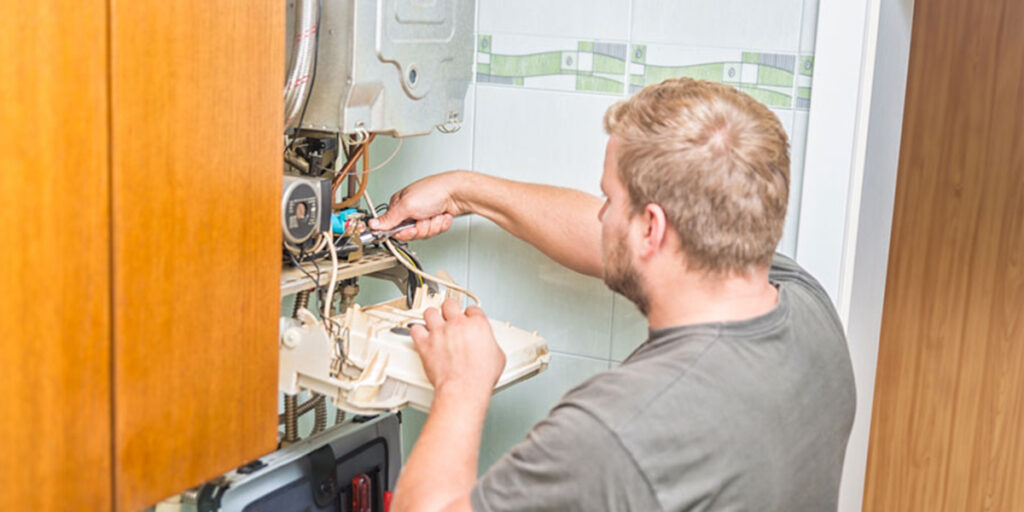Maintaining a comfortable home during Pennsylvania winters includes enjoying the warmth of your furnace. However, a poorly maintained or failing furnace may leak dangerous gasses into your home.
Are you unsure how to tell if your furnace is leaking carbon monoxide? Check out the list below to learn what signs to watch for and how to tell when you need to call Honey Brook’s heating and air conditioning company.
1. Problems With Your Pilot Light
The pilot light or burner flame ignites your burner’s furnace, enabling the system to heat your home. A malfunctioning or wrong-colored pilot light can indicate a carbon monoxide leak.
The most common signs of a pilot light affected by leaking carbon monoxide include the inability to stay light or yellow flames instead of blue ones. These symptoms show that your system keeps failing to properly fuel the pilot light, meaning that a line somewhere keeps leaking gasses involved in lighting the burner flame.
2. Poor Air Quality
Your home’s interior air quality will drop if your furnace develops a carbon monoxide leak. The air may feel stuffy or stale, or you may notice slight changes in your or your family members’ energy levels. You may even notice your pets reacting to the heavier air, presenting an irritable personality in place of a previously happy or calm disposition.
If you believe you have a problem with your indoor air quality, open your doors and let your home air out. Close the doors again and see how quickly your home again feels stale or stuffy. At this point, you should check if you have a carbon monoxide leak or call a professional to check it for you.
3. Rotten Egg Smells or Foul Odors
While you can’t see, smell, or taste carbon monoxide, one of the most common ways the gas gets into the air consists of a natural gas leak. City gas utility boards add a smell like rotten eggs to natural gas so homeowners and service providers can more easily identify a potential gas leak. If you smell rotten eggs or sulfur, you may have a natural gas leak spreading carbon monoxide into your home.
Another smell you might come across consists of a burning smell. This odor can indicate problems with your furnace’s gas line.
4. Condensation
Water buildup on windows close to your furnace may indicate leaking carbon monoxide. Whether from a fault heat exchanger or closed vent, humidity can collect in the air as a side effect of carbon monoxide present in the environment. If you notice water dripping down the windows closest to your furnace, call for a professional furnace repair specialist.
5. Higher Than Average Energy Bills
Searching for “how to tell if your furnace is leaking carbon monoxide” could answer this question by glancing at their energy bills. If you notice a rise in your gas usage with no explanation, a gas line may have cracked or disconnected, leaking carbon monoxide into your home.
6. You or Someone In Your Family Exhibits Signs of Carbon Monoxide Poisoning
If a carbon monoxide leak continues for too long, you or some of your family members may exhibit symptoms of carbon monoxide poisoning. This dangerous condition can mimic many other illnesses, causing confusion if you don’t know what you’re looking for. Some symptoms of carbon monoxide poisoning may include:
- Nausea
- Vomiting
- Dizziness
- Headache
- Confusion
- Weakness
- Passing out
- Blurred vision
- Shortness of breath
Some carbon monoxide poisonings occur while a home’s residents sleep, causing them severe brain damage or death. If you suspect your home has a carbon monoxide leak or have noticed any of these symptoms with no other potential causes, hire a professional to test your home for carbon monoxide levels.
What to Do If You Spot Carbon Monoxide Poisoning Symptoms
Should you notice that you or a family member exhibits signs of carbon monoxide poisoning, get every person and pet out of the house and into fresh air. If more severe symptoms like fainting or vomiting persist, get immediate medical attention. Before re-entering your home, have a professional furnace repair specialist check and fix your malfunctioning furnace.
How Can I Avoid Carbon Monoxide Leaks From My Furnace?
Homeowners wanting to ensure the safest and most comfortable homes should practice these methods for protection from carbon monoxide poisoning:
Install Carbon Monoxide Detectors
A well-known myth about carbon monoxide detectors consists of placing the detectors close to the ground because carbon monoxide has a heavier weight than air. Carbon monoxide actually weighs similar to air, dispersing itself into the surrounding environment and mixing with your regular air.
Place or move carbon monoxide detectors at least five feet above the ground. Place at least one close to the furnace so you have an early detection system in place for potential gas leaks.
Keep Up With Regular Furnace Maintenance
Furnaces contain many delicate components, each of which require special care to keep in good condition. Failing to engage in regular furnace maintenance not only creates conditions more likely to cause problems, but means that you’ll miss early warning signs of a failing or malfunctioning part. While you can attempt to maintain your own furnace, hiring professionals provides repairs right when the technician discovers an issue.
Replace an Old Furnace or Old Furnace Equipment
Older furnaces fail more frequently than newer furnaces, with most of them requiring replacement after 10 years of service. Besides the entire system failing, parts like pipes and gas lines can break or deteriorate. Replacing old furnace components or upgrading can help you avoid potential carbon monoxide leaks.
Enjoy the Best Air Quality With Topline Heating & Air
Carbon monoxide poisoning can cause severe symptoms all the way up to death, making it an incredibly dangerous problem to have in your home. Wondering “how to tell if your furnace is leaking carbon monoxide” means you may have already noticed some of these symptoms or signs mentioned above. When you suspect carbon monoxide poisoning or a broken or malfunctioning furnace, call (717) 628-6825 to work with Topline Heating & Cooling, Honey Brook, PA’s top furnace repair specialists.



